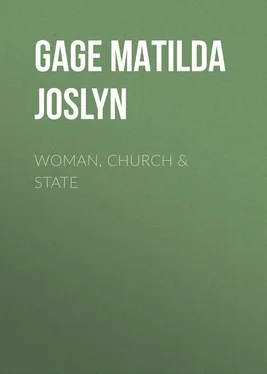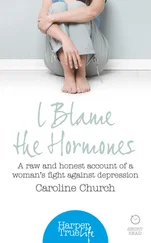Matilda Gage - Woman, Church & State
Здесь есть возможность читать онлайн «Matilda Gage - Woman, Church & State» — ознакомительный отрывок электронной книги совершенно бесплатно, а после прочтения отрывка купить полную версию. В некоторых случаях можно слушать аудио, скачать через торрент в формате fb2 и присутствует краткое содержание. Жанр: foreign_antique, foreign_prose, на английском языке. Описание произведения, (предисловие) а так же отзывы посетителей доступны на портале библиотеки ЛибКат.
- Название:Woman, Church & State
- Автор:
- Жанр:
- Год:неизвестен
- ISBN:нет данных
- Рейтинг книги:3 / 5. Голосов: 1
-
Избранное:Добавить в избранное
- Отзывы:
-
Ваша оценка:
- 60
- 1
- 2
- 3
- 4
- 5
Woman, Church & State: краткое содержание, описание и аннотация
Предлагаем к чтению аннотацию, описание, краткое содержание или предисловие (зависит от того, что написал сам автор книги «Woman, Church & State»). Если вы не нашли необходимую информацию о книге — напишите в комментариях, мы постараемся отыскать её.
Woman, Church & State — читать онлайн ознакомительный отрывок
Ниже представлен текст книги, разбитый по страницам. Система сохранения места последней прочитанной страницы, позволяет с удобством читать онлайн бесплатно книгу «Woman, Church & State», без необходимости каждый раз заново искать на чём Вы остановились. Поставьте закладку, и сможете в любой момент перейти на страницу, на которой закончили чтение.
Интервал:
Закладка:
3. When the parents of a girl on her marriage day say to the bridegroom: “Whatever act of religion you perform, perform it with our daughter,” and the bridegroom assents to this speech.
The comparatively modern custom of suttee originated with the priests, whose avaricious desires created this system in order thereby to secure the property of the widow. The Vedas do not countenance either suttee or the widow’s relinquishment of her property, the law specifically declaring, “If a widow should give all her property and estate to the Brahmins for religious purposes, the gift indeed is valid, but the act is improper and the woman blamable.” An ancient scripture declares that “All the wisdom of the Vedas, and all that has been written in books, is to be found concealed in the heart of a woman.” It is a Hindoo maxim that one mother is worth a thousand fathers, because the mother carries and nourishes the infant from her own body, therefore the mother is most reverenced. A Hindoo proverb declares that “Who leaves his family naked and unfed may taste honey at first, but shall afterwards find it poison.” Another says, “A wife is a friend in the house of the good.”
Ancient Egypt worshiped two classes of gods; one purely spiritual and eternal, the other secondary but best beloved, were believed to have been human beings who from the services they had rendered to humanity were upon death admitted to the assembly of the gods. Such deification common in ancient times, is still customary in some parts of the earth. Within the past few years a countryman of our own was thus apotheosized by the Chinese to whom he had rendered valuable service at the time of the Tae-ping rebellion. 25 25 Ward, the American who rendered such service to the Chinese Emperor, has been deified. The Emperor, in a recent edict, has placed him among the major gods of China, commanding shrines to be built and worship to be paid to the memory of this American. The people are worshiping him along with the most ancient and powerful deities of their religion as a great deliverer from war and famine – as a powerful god in the form of man. In every household, school and temple, his name will be thus commemorated. — Newspaper Report .
Ancient Egyptians recognized a masculine and feminine principle entering in all things both material and spiritual. Isis, the best beloved and most worshiped of the secondary gods, was believed by them to have been a woman who at an early period of Egyptian history had rendered that people invaluable service. She was acknowledged as their earliest law-maker, through whose teaching the people had risen from barbarism to civilization. She taught them the art of making bread 26 26 Diodorus Siculus .
from the cereals theretofore growing wild and unused, the inhabitants at an early day living upon roots and herbs. Egypt soon became the grain growing portion of the globe, her enormous crops of wheat not alone aiding herself, but rendering the long stability of the Roman Empire possible. The science of medicine was believed to have originated with Isis; she was also said to have invented the art of embalming, established their literature, founded their religion. The whole Egyptian civilization was ascribed to the woman-goddess, Isis, whose name primarily Ish-Ish, signified Light, Life. 27 27 “I am nature, the parent of all things, the sovereign of the elements, the primary progeny of time, the most exalted of the deities, the first of the heavenly gods and goddesses, the queen of the shades, the uniform countenances who dispose with my rod the innumerable lights of heaven.”
Isis, and Nepthys – the Lady of the House – were worshiped as the Beginning and the End. They were the Alpha and Omega of the most ancient Egyptian religion. The statues of Isis bore this inscription:
I am all that has been, all that shall be, and none among mortals has hitherto taken off my veil.
Isis was believed to contain germs within herself for the reproduction of all living things. The most universal of her 10,000 names was, “Potent Mother Goddess.” 28 28 The salubrious breezes of the sea, and the mournful silence of the dead whose single deity the whole world venerates in many forms with various rites and many names. The Egyptians, skilled in ancient lore, worship me with proper ceremonies and call me by my true name – Queen Isis.
This Egyptian regard for Isis is an extremely curious and interesting reminiscence of the Matriarchal period. Her worship was universal throughout Egypt. Her temples were magnificent. Her priests, consecrated to purity, were required to bathe daily, to wear linen garments unmixed with animal fibre, to abstain from animal food, and also from those vegetables regarded as impure. 29 29 Leeks, garlic, onions and beans.
Two magnificent festivals were yearly celebrated in her honor, the whole people taking part. During one of these festivals her priests bore a golden ship in the procession. The ship, or ark, 30 30 All the ancient nations appear to have had an ark or archa, in which to conceal something sacred. – Godfrey Higgins, Anacalypsis I , 347.
is peculiarly significative of the feminine principle, and wherever found is a reminiscence of the Matriarchate. The most sacred mysteries of the Egyptian religion, whose secrets even Pythagoras could not penetrate, to which Herodotus alluded with awe, and that were unknown to any person except the highest order of priests, owed their institution to Isis, and were based upon moral responsibility and a belief in a future life. The immortality of the soul was the underlying principle of the Egyptian religion.
Isis seems to have been one of those extraordinary individuals, such as occasionally in the history of the world have created a literature, founded a religion, established a nationality. She was a person of superior mentality, with power to diffuse intelligence.
Moses, “learned in all the wisdom of the Egyptians,” borrowed much from Isis. The forms and ceremonies used in her worship were largely copied by him, yet lacked the great moral element – immortal life – so conspicuously taught as a part of Egyptian religion. The Sacred Songs of Isis were an important part of the literature of Egypt. Plato, who burned his own poems after reading Homer, declared them worthy of the divinity, believing them to be literally 10,000 years old. 31 31 The Sacred Song of Moses and Miriam was an early part of Jewish literature; the idea was borrowed like the ark from the religion of Isis.
All orders of the priesthood were open to women in Egypt; sacred colleges existed for them, within whose walls dwelt an order of priestesses known as “God’s Hand,” “God’s Star.” Its ranks were recruited from women of the principal families, whose only employment was the service of the gods. “Daughter of the Deity,” signified a priestess.
Women performed the most holy offices of religion, carrying the Sacred Sistrum and offering sacrifices of milk, both ceremonies of great dignity and importance, being regarded as the most sacred service of the divinity. Such sacrificial rites were confined to queens and princesses of the royal household. Ames-Nofri-Ari, a queen who received great honor from Egyptians, spoken of as the “goddess-wife of Amun,” the supreme god of Thebes, for whose worship the wonderful temple of Karnak was founded by a Pharaoh of the XII dynasty, is depicted on the monuments as the Chief High Priest – the Sem, whose specific duty was offering sacrifices and pouring out libations in that temple. By virtue of her high office she preceded her husband, the powerful and renowned Rameses II. The high offices of the church were as habitually held by women as by men; Princess Neferhotep, of the fifth dynasty, was both a priestess and a prophetess of the goddesses Hathor and Neith, the representatives of celestial space, in which things were both created and preserved.
Читать дальшеИнтервал:
Закладка:
Похожие книги на «Woman, Church & State»
Представляем Вашему вниманию похожие книги на «Woman, Church & State» списком для выбора. Мы отобрали схожую по названию и смыслу литературу в надежде предоставить читателям больше вариантов отыскать новые, интересные, ещё непрочитанные произведения.
Обсуждение, отзывы о книге «Woman, Church & State» и просто собственные мнения читателей. Оставьте ваши комментарии, напишите, что Вы думаете о произведении, его смысле или главных героях. Укажите что конкретно понравилось, а что нет, и почему Вы так считаете.












